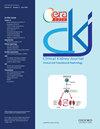诱饵受体是探索病因和设计新疗法的生物标志物
IF 3.9
2区 医学
Q1 UROLOGY & NEPHROLOGY
引用次数: 0
摘要
可溶性诱饵受体(DR)是一种循环蛋白,可作为配体的分子陷阱,调节各种信号通路。这些蛋白质可用作生物标记物,在某些情况下还可用作治疗各种疾病的药物。炎症是 DRs 显示出巨大潜力的一个关键领域。通过与促炎症细胞因子结合,炎症 DRs(如可溶性肿瘤坏死因子受体(sTNFR))可以抑制下游炎症信号传导。这种对炎症反应的调节有望用于各种炎症的治疗干预,包括心血管疾病和慢性肾脏疾病。可溶性高级糖化终末产物 DRs(sRAGE)能与高级糖化终末产物(AGEs)结合,减少其对血管功能和动脉粥样硬化的不利影响。高水平的循环 sRAGE 与较低的冠状动脉事件风险相关,凸显了这些可溶性受体在评估 AGEs 在冠状动脉疾病中的作用和管理随之而来的风险方面的潜力。DRs可作为生物标记物和治疗药物,促进我们对疾病机制的了解并改善患者的预后。DRs 能够以可控的方式调节信号通路,这为治疗干预各种疾病(从炎症到心血管疾病和肾脏疾病)提供了新的机会。本文章由计算机程序翻译,如有差异,请以英文原文为准。
Decoy receptors as biomarkers for exploring aetiology and designing new therapies
Soluble Decoy receptors (DR) are circulating proteins that act as molecular traps for ligands that modulate various signalling pathways. These proteins can be exploited as biomarkers and, in some cases, as drugs in various disease contexts. Inflammation is a key area where DRs have shown significant potential. By binding to pro-inflammatory cytokines, inflammatory DRs, like soluble tumour necrosis factor receptors (sTNFRs), can inhibit downstream inflammatory signalling. This modulation of the inflammatory response holds promise for therapeutic interventions in various inflammatory conditions, including cardiovascular and chronic kidney diseases. Soluble DRs for advanced glycation end products (sRAGE) bind to advanced glycation end products (AGEs), reducing their detrimental effects on vascular function and atherosclerosis. High circulating sRAGE levels are associated with a lower risk for CV events, highlighting the potential of these soluble receptors for assessing the role of AGEs in CV diseases and managing the attendant risk. DRs may serve as biomarkers and therapeutic agents to advance our understanding of disease mechanisms and improve patients' outcomes. Their ability to modulate signalling pathways in a controlled manner opens new opportunities for therapeutic interventions in various diseases, ranging from inflammation to cardiovascular and renal disorders.
求助全文
通过发布文献求助,成功后即可免费获取论文全文。
去求助
来源期刊

Clinical Kidney Journal
Medicine-Transplantation
CiteScore
6.70
自引率
10.90%
发文量
242
审稿时长
8 weeks
期刊介绍:
About the Journal
Clinical Kidney Journal: Clinical and Translational Nephrology (ckj), an official journal of the ERA-EDTA (European Renal Association-European Dialysis and Transplant Association), is a fully open access, online only journal publishing bimonthly. The journal is an essential educational and training resource integrating clinical, translational and educational research into clinical practice. ckj aims to contribute to a translational research culture among nephrologists and kidney pathologists that helps close the gap between basic researchers and practicing clinicians and promote sorely needed innovation in the Nephrology field. All research articles in this journal have undergone peer review.
 求助内容:
求助内容: 应助结果提醒方式:
应助结果提醒方式:


